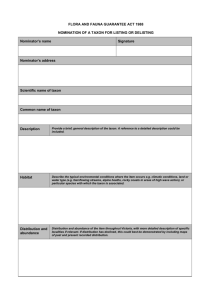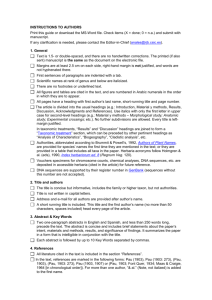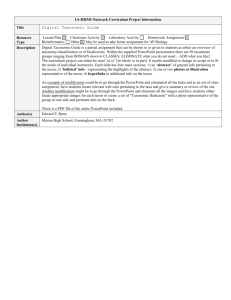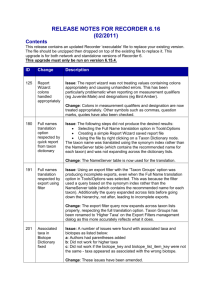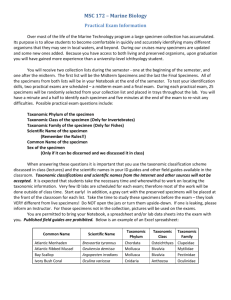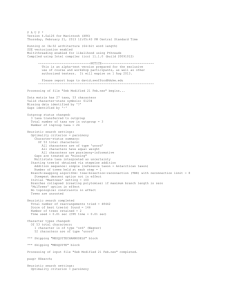Taxonomic Concept Models
advertisement
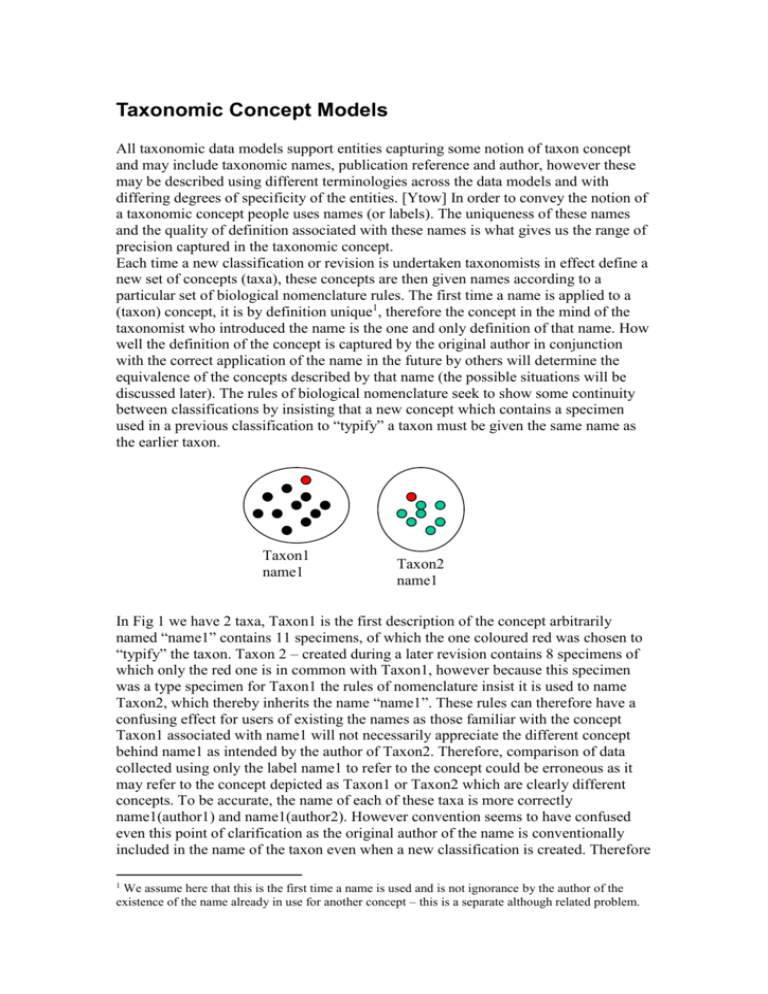
Taxonomic Concept Models All taxonomic data models support entities capturing some notion of taxon concept and may include taxonomic names, publication reference and author, however these may be described using different terminologies across the data models and with differing degrees of specificity of the entities. [Ytow] In order to convey the notion of a taxonomic concept people uses names (or labels). The uniqueness of these names and the quality of definition associated with these names is what gives us the range of precision captured in the taxonomic concept. Each time a new classification or revision is undertaken taxonomists in effect define a new set of concepts (taxa), these concepts are then given names according to a particular set of biological nomenclature rules. The first time a name is applied to a (taxon) concept, it is by definition unique1, therefore the concept in the mind of the taxonomist who introduced the name is the one and only definition of that name. How well the definition of the concept is captured by the original author in conjunction with the correct application of the name in the future by others will determine the equivalence of the concepts described by that name (the possible situations will be discussed later). The rules of biological nomenclature seek to show some continuity between classifications by insisting that a new concept which contains a specimen used in a previous classification to “typify” a taxon must be given the same name as the earlier taxon. Taxon1 name1 Taxon2 name1 In Fig 1 we have 2 taxa, Taxon1 is the first description of the concept arbitrarily named “name1” contains 11 specimens, of which the one coloured red was chosen to “typify” the taxon. Taxon 2 – created during a later revision contains 8 specimens of which only the red one is in common with Taxon1, however because this specimen was a type specimen for Taxon1 the rules of nomenclature insist it is used to name Taxon2, which thereby inherits the name “name1”. These rules can therefore have a confusing effect for users of existing the names as those familiar with the concept Taxon1 associated with name1 will not necessarily appreciate the different concept behind name1 as intended by the author of Taxon2. Therefore, comparison of data collected using only the label name1 to refer to the concept could be erroneous as it may refer to the concept depicted as Taxon1 or Taxon2 which are clearly different concepts. To be accurate, the name of each of these taxa is more correctly name1(author1) and name1(author2). However convention seems to have confused even this point of clarification as the original author of the name is conventionally included in the name of the taxon even when a new classification is created. Therefore 1 We assume here that this is the first time a name is used and is not ignorance by the author of the existence of the name already in use for another concept – this is a separate although related problem. a more proper name for the taxon should be name1(author1) and name1(author1)author2, i.e. TheName(TheOriginalAuthoroftheName)(TheTaxonRevisionAuthorname). However, if the same author undertook a later revision of the same group, then we would also need a date to clarify the “version” of the concept by that author. This then would uniquely identify any concept created as a result of a scientific revision (the author and date is often captured in a publication of that date by the author). Therefore to uniquely identify a taxon concept we require The taxon name, the original author of the name(of the type specimen), the author of the revision and the date (or publication reference). The lack of any of this information reduces the accuracy of the reference to a taxon concept. We could therefore define 72 categories of label 1. Name 2. Name plus type author 3. Name plus type author plus classification author 4. Name plus type author plus classification author plus date (or pub) plus optionally the following: 5. Name plus classification author 6. Name plus date 7. Name plus classification author plus date The problem of naming is compounded when considering the inclusion of common names possibly in different languages, however a similar approach is required to address these. Even if we have uniquely labelled or named a concept this does not inform other users of the name as to its meaning. Definitions are often not published at all, which leaves the user to interpret the meaning based (in the worst case) on the fact that to be named “name1” the concept must be inclusive in some way the some of the characteristics of the type specimen of Taxon1 and the name “name1”. However the particular characteristics of the specimen which scope the concept is not clear and thereby leaves room for considerable interpretation by the user. The clarity of the meaning can be improved by the provision of additional information. If the full classification or revision in which the taxon exists is available, then this gives the user some feel for the number of different concepts recognised by the author and from the names of these some indication3 of the range of type specimens considered. These two pieces of information are the most commonly found “definitions” in what are termed authority lists. Improving the definition further can be achieved in 3 ways. The first is to record references to all specimens used in a revision and thereby allow anyone to in the future to return to the original specimens4 to get a feel for what meaning the author had regarding the concept at the point of creation. This again leaves room for interpretation but gives a better circumscription of the concept that simply the type specimen. Consider again Figure 1, knowing that the two taxa had a similarity of approx. 10% in terms of commonality of specimens might lead the user to consider that they were quite different concepts, whereas information only on the existence of This might not be the correct set of categories…….. It must be noted that this does not give any indication of the completeness of cover of specimens including relevant type specimens used during the revision process, which could in itself be misleading. 4 Thereby recording the raw data which can be validated as opposed to derived data. 2 3 the type specimen would leads the user to consider they were in fact the same concept. In order to be sure what the original author meant we would need in addition (or possibly alternatively) to record the second mechanism for capturing the definition - recording the specific characteristics of the specimens that the author considered important in differentiating the taxa within the revision. Recording characteristics of specimens opens another similar can of worms in terms of understanding the definition captured by the characteristics recorded. Firstly, there is the issue of which characters are recorded. Tradition has developed that only characters that distinguish taxa are recorded in detail. If this is the case it is impossible to get a full understanding of the definition of a taxon without comparing it to all other taxa described in the revision and having a prior knowledge of the assumptions in the authors mind as to what characters differentiated the group under consideration form all other taxa and thereby specimens. So although useful for creating a revision by differentiating taxa this method is limited in describing the actual taxon concept in its totality. To fully capture the definition of the taxon all the characteristics that define it must be recorded. Secondly, interpreting the meaning of the terms used to describe the specimen characteristics is equally uncertain and without an agreed ontology with workable definitions for these terms which authors agree to use, the comparability of taxa definitions is also prone to error5. Finally, the definition of a concept can be captured by including relationships from that concept to other concepts. For example, when a taxonomist creates a new revision and therefore new concept, he can specify what he thinks the relationship between his concept and previous concepts are. We can therefore consider X categories of definitions for concepts. 1. Type specimen 2. Full specimen circumscription (includes 1) 3. Related classification, i.e. name circumscription details for related taxa 4. Differentiating character description 5. Full character description (includes 4) 6. Set of synonymy relationships to other taxa6 7. 2+3 8. 2+3+4 9. 2+3+5 10. 4+6 On top of all of this we may wish to consider the quality of the actual work, in terms of the coverage of the revision, the expertise or knowledge of the author, the quality of the publication in terms of its intended audience, all of which may give some bearing on the quality of definition of the taxon concept. The coverage of revision and the expertise of the author is subjective and is not something easily measurable, however it is reasonable to imagine that there could be a set of categories7 for taxonomic concept publications. 1. Monographs 2. Floras 3. ….. 5 In fact we have at this point reached the same problem in natural language as we have in defining taxon concepts and many of the same arguments apply recursively. 6 It is not clear how to decide the quality of these relationships nor the number required to be useful 7 This is incomplete and needs further discussion and reasoning but the principal should be sound. 4. Lists 5. …. 6. Guidebooks Each of these could be described in terms of the information contained within to aid the understanding of the taxonomic concepts described. This would allow some capture of the usage of concepts according to particular authorities (via lists or handbooks of varying “quality”). An on-line checklist could encourage scientists to ensure that their data is published in reputable sources and to support agreement on the categorisation of lists. The accuracy of usage required for a taxon concept is dependent on how that information will be used and what will be inferred from any analysis of this information. Therefore if the above categories were combined (additively or as separate sub-scores) to define a score for the accuracy of a concept definition, the user could specify which level of precision any results should adhere to, which would restrict the data sets returned for any given analysis. For example we might rank the categories according to accuracy/quality and use the number of the category to rank the quality of a taxonomic concept. At one extreme there is the use of the name with no record of the concept definition. Taking this the re-application of a published name without reference to the original taxonomic concept definition and publication. The score for such a concept would be something like 1.0.0.0.8 and the interpretation of this concept is likely to be dependent on the individual author and can result in the notion that any use of the name is potentially a different taxon concept. This is the basis of the potential taxon according to Berendsohn. If we have a situation where every application of a name to a concept results in a potentially different (new?) concept, then we have the situation where we cannot undertake any comparative work with other scientists and the only valid comparative work is that done by a single author using concepts he has defined and even this is debatable as a person’s concept of something can evolve over time and the same “concept” might not be equivalent. This is a phenomenon of natural language and is impossible to prevent, however it does not prevent us communicating with others although misunderstandings do frequently occur. In the scientific domain it is important that we allow the possibility for concepts to evolve in order to increase or evolve our understanding of the natural world, however this evolution needs to be controlled to some extent to allow comparative analysis to take place. For better defined concepts we might have a full taxonomic name plus reference to the author and date (4) for which the author is a renowned expert(1) who has published his work in a renowned publication(1) with full description of the specimens considered and full character description(8) which would have a score of 4.8.1.1. (Going towards Prometheus) Finally to exemplify the idea we may have a full taxonomic name (3) with reference to a renowned publication describing the differentiating taxonomic characters(1) by a renowned author (1) and a list of relationships to other taxa(6) Giving a score of 3.10.1.1. (Going towards Vegbank – but needs work!) 8 The score is NameScore.DefinitionScore.PublicationQualityScore.AuthorQualityScore In order to compare the different taxonomic models we can define Taxonomic concepts and the sub-types of components that define a taxonomic concept. Models will optionally support a range of these components and will allow us to compare at the model level in addition to the data level.9 9 Models can often support more data than is actually defined for any given concept.

